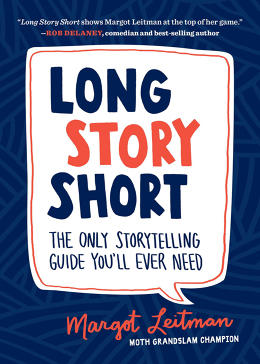6 rules for excellent Storytelling, From A Moth-authorized grasp Of the shape
Moth storytelling champ Margot Leitman has been hired through facebook and others to help them discover ways to spin a yarn. These are her principles.
October 21, 2015
Some years ago, writes Margot Leitman in her new book, lengthy Story quick: the one Storytelling guide you can Ever want, when she used to be an aspiring actress in ny, she used to be preparing to rush to an audition when she burned her neck with a curling iron. “It seemed like an enormous hickey,” she writes. “There used to be no makeup that might duvet it up; I needed to go together with it.” She entered the audition room and defined away the burn—not a hickey, she said; her courting historical past had been awful nowadays. The casting director asked her to provide an explanation for, and she or he replied with a story about a disastrous recent date the place the guy if truth be told balanced his checkbook at the desk.

She had the casting director laughing earlier than she even learn for the part. and a few days later, she acquired the decision announcing she got it.
It used to be a moment that crystallized for Leitman the facility that tales can have. quickly, she started out to shift her performing energies in opposition to are living storytelling. She based lengthy-operating storytelling shows and courses at Upright voters Brigade in each big apple and los angeles, including a sex-themed show known as “Stripped tales,” and she’s received storytelling competitions a number of occasions at The Moth. She offers workshops at places like universal McCann and fb, companies that reckon good storytelling is just right verbal exchange, and good conversation is trade. She has taught, by way of her personal depend, hundreds of students so far.
And now, with lengthy Story short hitting cabinets and screens all over, Leitman shares with quick firm just a few key classes on storytelling from her guide.
Lesson 1: Make folks Root For You
“In everything from politics to acting,” says Leitman, “the right way to get ahead is ceaselessly to get folks to root for you.” When starting a story, first quick introduce yourself as a clear persona: “I’m the type of man/girl who . . . ” your next step will run towards the grain of what you’ve been taught about methods to present your self. In interviews and resumes, you’re supposed to speak your self up. however in storytelling, individuals want to root for an underdog. Storytelling shouldn’t be pitching. “When folks pitch themselves, I’m delay by that.” Puffing yourself up makes folks want to take you down a notch. When invoice Clinton insisted he “didn’t inhale,” nobody might let it go, reminds Leitman. but when Obama easily admitted to smoking in his adolescence, people recommended his honesty and moved on.
Lesson 2: Have a few Go-To stories at the ready
You will have to have a elegant story or two on your repertoire. You by no means know when it’ll turn out to be useful, says Leitman, pointing to a second in Steve Jobs’s authentic iPhone keynote when the slide deck failed, and he sprung gracefully into a story he had at the ready. “i feel it used to be a story he informed socially 1,000,000 occasions,” says Leitman. “most probably it labored socially, so he made up our minds to tell it in front of the gang. To me, it’s probably the most memorable part of that speech. moderately than speaking about the components of the iPhone, he’s taking a moment that makes him human.”

Lesson 3: stories Are About the way you Felt
“It’s in point of fact no longer what transpired that makes a just right story,” says Leitman, upending typical wisdom. “It’s about the way you felt about what transpired.” The “plot” of your story is sort of beside the point in relation to making a connection along with your target audience. “It’s not a topic of, ‘We gained the sport.’ It’s, ‘How did you’re feeling when you gained? What did you imagine used to be not possible that now you can do?’” A corollary of this: tales can also be about very small stuff, provided that the feelings involved are large. Leitman tells a narrative about wandering into a whole foods in the middle of a personal scientific nightmare. The cashier invited her to donate to the Haiti earthquake relief, and an emotional Leitman signed over $50. “The cashier said, ‘Wow, you’re a in reality nice individual.’ I began crying, ‘i’m! i’m! a good individual!'” although small in scale, the story always will get a laugh.
Lesson 4: this may occasionally seem obvious, but . . .
“tales have a beginning, center, and an finish,” says Leitman. sure, it sounds glaring, but in years of educating storytelling, she wouldn’t repeat this fact if it weren’t essential. take into accounts it: have you ever ever been at a marriage and heard probably the most toast-givers drone on and on, with out center of attention? “lots of people never get to the story. I don’t be aware of why they are able to’t. however they talk and speak and never get to some extent,” she says.
it would have one thing to with the fact that lifestyles itself is noisy; we glide around, we now have trouble discovering the thread. “but it’s something that can be taught simply,” she promises. Leitman herself one way or the other at all times had the lesson internalized, she says, telling about the 22-page journal entry she wrote about shedding her virginity. She wrote about all the hours prior to the experience, and the whole thing after. “My God, it wanted an edit. but I kind of obtained it even then!”
Lesson 5: just right stories Are universal
Your story needs to framed inclusively; there has to be something your audience identifies with. Leitman remembers a scholar who commenced a narrative, “So I went to Yale.” The story that got here after used to be really attention-grabbing and funny, about being seized with paranoia that a automobile was once following him. however his opener, “I went to Yale,” didn’t mean for many audiences what the scholar idea it did. For him, “I went to Yale” instantly communicated, ” . . . which is in New Haven, Connecticut, which has some bad neighborhoods in it.” however all anyone else heard was: “I went to a flowery unique faculty.” It used to be an invitation for many audiences to tune out. The lesson has an analogue in a time period from tech and design: attempt to consider the “consumer experience” of your story.
Lesson 6: don’t be Boring
Leitman doesn’t mean that your story shouldn’t be boring (although which is true, too). She means you must cease living a boring life. This lesson will have to be enthusiastic about a grain of salt, because she believes that all of us who’ve been on this earth just a few years have a trove of news value telling. nonetheless, why not use your newfound passion in storytelling to reconsider a few of your possibility-avoidant habits? “We get right into a groove in life the place we get scared of making an attempt new things,” says Leitman. “you must say sure to issues that scare you, otherwise you received’t have an extraordinarily story-precious existence. And the legacy that goes on after you go are the tales people tell about you.”
She impersonates a eulogist fumbling awkwardly for something to say concerning the deceased: “She . . . in reality liked her DVR.”
related: tv Legend Norman Lear Tells a narrative About How He Busted creator’s Block
(72)














